Komentáře (0)

*Translated by google translator
Synthetic opals stand out with strong colors, some look almost like natural and are much cheaper than natural.
But what exactly is synthetic opal? Is it a full-fledged replacement for natural opals? Are they as good as other synthetic gems? And is there a difference in the quality of synthetic opals?
In this article, I will try to explain all the information and important facts.
Important facts
Synthetic opal does not exist as a full-fledged substitute for natural opal.
As the first and most important information about synthetic opal, it is by no means a full-fledged replacement for natural opal. There are many types of artificial opals, from just imitation opal to quality synthetic opals, but none can be considered a full-fledged substitute.
Synthetic opal is not a synthetic gem
Official definition of synthetic stone: A synthetic gemstone must have the same composition as a natural stone in order to be called a synthetic gemstone. Synthetic opal has only a composition similar to natural opaque, so it cannot be called a synthetic gemstone. Synthetic opal is just another name for a more expensive imitation of opal.
The world of precious opals and the world of synthetic opals are two completely different worlds
Before embarking on a detailed analysis, I would first state the most important fact why synthetic opal is not and will never be a full-fledged substitute for natural opal. It may seem like a struggle between two worlds, but the fact is that synthetic opal has almost nothing to do with nature.
In the world of natural precious opals, everything revolves around color change (opalescence). It is also the first thing that interests us at first sight. It was as if all the colors of other gems could be seen in a single stone. In addition, color is an absolutely crucial and decisive factor when valuing natural expensive opals. Color content, color intensity, color composition, predominant colors, color pattern, everything has a big impact on the price. The weight, location, size or shape of the cut are taken into account as a secondary one. Even in this, expensive opal is unique.
The color structure of each natural opal is so unique that every precious opal becomes a complete original.

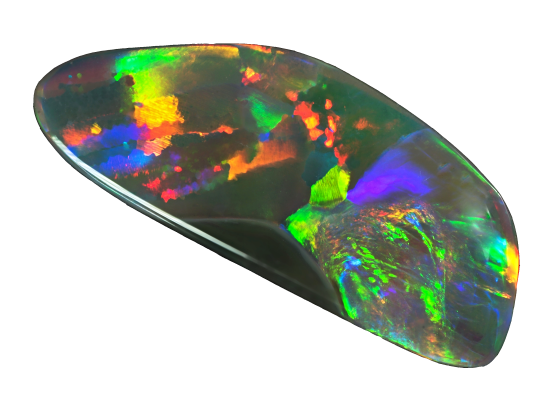
One has a little more green, another has a higher color intensity, another has a slightly different color composition, internal inclusions, sandy places and many other factors that make each expensive opal unique.
It is not economically advantageous to produce each piece of synthetic opal separately, as nature can.
The development of synthetic opal is not aimed at fully replacing natural opal, but only to imitate it cheaply, completely for commercial purposes. The world of synthetic opal is therefore different. It also contains paints and similar chemical compositions, but the decisive factor is its production cost. This purpose of production does not curse or fight the world of natural opals. It has its place clearly given in artificial products.
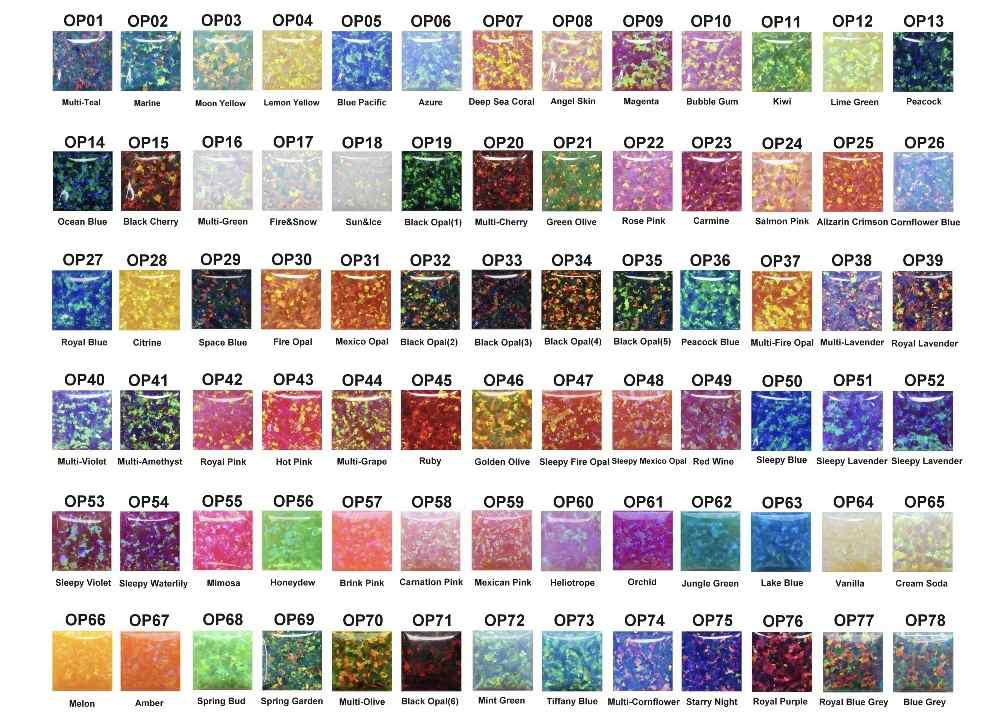
Synthetic opal is often presented as just a cheaper option for natural opals, and this arouses understandable disappointment in the world of natural opal.
As if someone were convincing you that cut glass has the same cut and the same color as a diamond, it just has a slightly different composition and properties, but otherwise it is a full-fledged replacement for natural diamond and it is also cheaper. You would probably tap your forehead if it was normal. Unfortunately, this is completely normal in the world of synthetic opal. As diamond sellers will not sell cut glass at the same time, natural opal sellers will not sell synthetic opal for the same reason.
Imitation opal
Imitation or imitation or artificial opal.
Imitation opal has only an optical effect similar to natural opal. Chemical composition and properties are different.
Plastics, glass or other materials are used for production.
Slocum stone (Slocum opal)
is one of the first imitations to be popular shortly before the introduction of synthetic opal and cheaper imitations. Glass material that mimics the look of opal.

Opalit - Opalite
is a commonly known imitation. It shows no color play and simulates ordinary opal. This synthetic glass is characterized by a special optical effect, reminiscent of the somewhat bluish luster of the moonstone.

Opal-like Plastic (OLP)
• Composition: 20% silica + 80% resin
is certified by the GIA as an imitation opal. Some mistakenly refer to OLP as synthetic opal. OLP is a plastic material with a certain color change effect.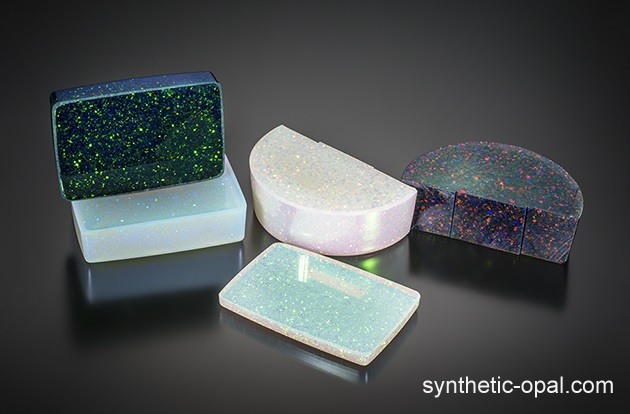
Aurora opál
• Composition: 15 to 20% silica + 85 to 80% resin
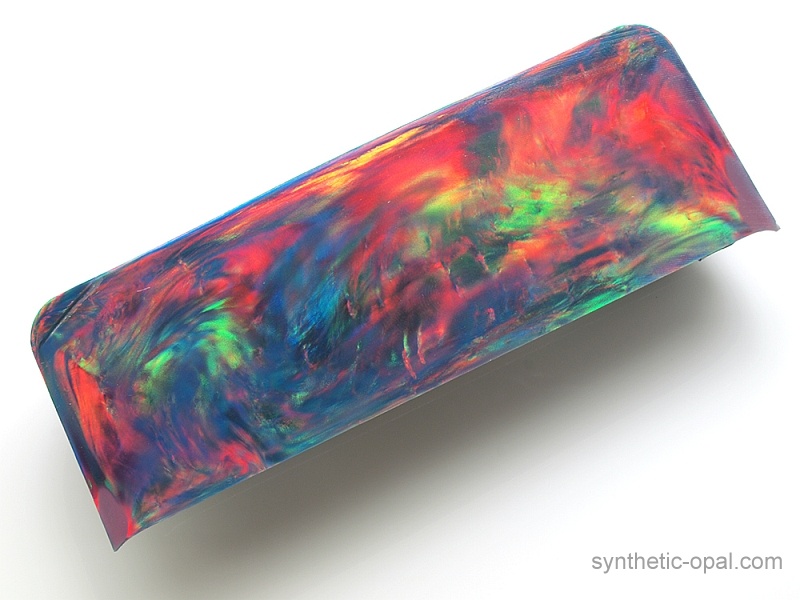
Laboratory-treated synthetic opal
• Composition: 15 to 20% silica + 85 to 80% resin
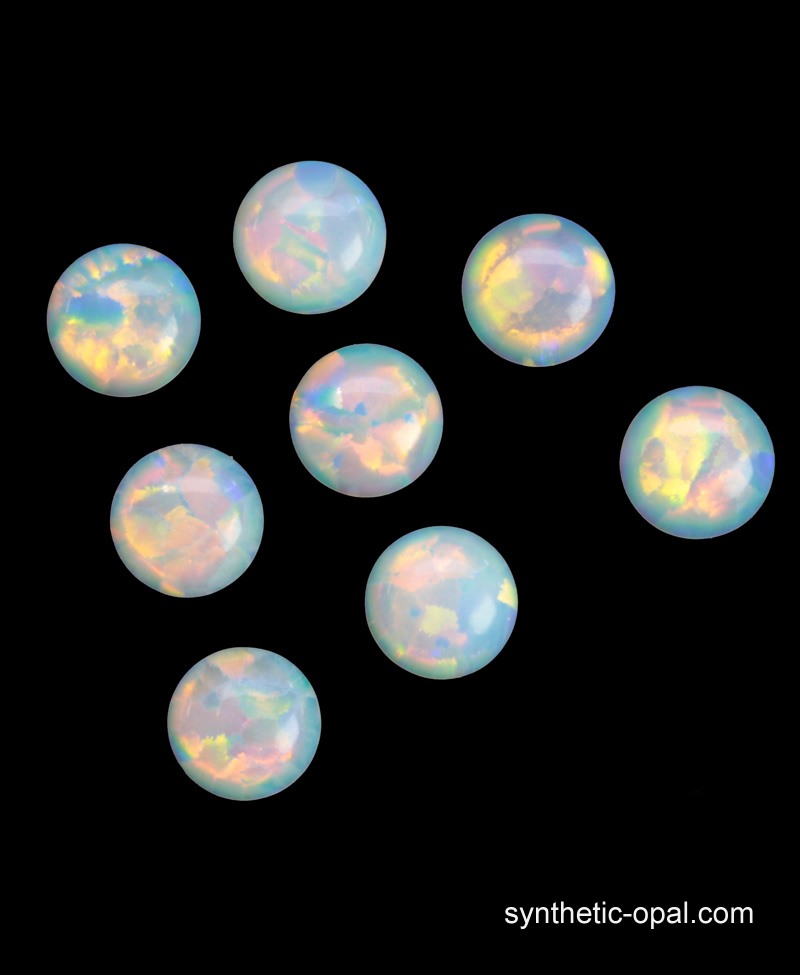
Aurora Opal and Laboratory-Modified Synthetic Opal are imitations of high-level opals. Their production is much more expensive and sophisticated than cheap imitations. The name may differ depending on the synthetic opal retailer.
Synthetic Opal
• Natural opal: SiO2.nH2O
• Synthetic opal: SiO2.nH2O + resin
Synthetic opal has a similar chemical composition and gemological properties to natural opal.
The structure of the dye is still different from natural opal, it contains resin or other additives that do not occur in natural opal.
Monarch Opal (Galaxy Opal, Bello Opal, Sterling Opal)
• 80% silica + 20% resin
The latest synthetic opal with many names. The researchers modified the process from the Gilson Company to create a structure known as lizard skin. The chemical composition is closest to the natural, but it is still impregnated and contains additives that the natural opal does not contain. It is also referred to as "Polymer-impregnated synthetic opal"
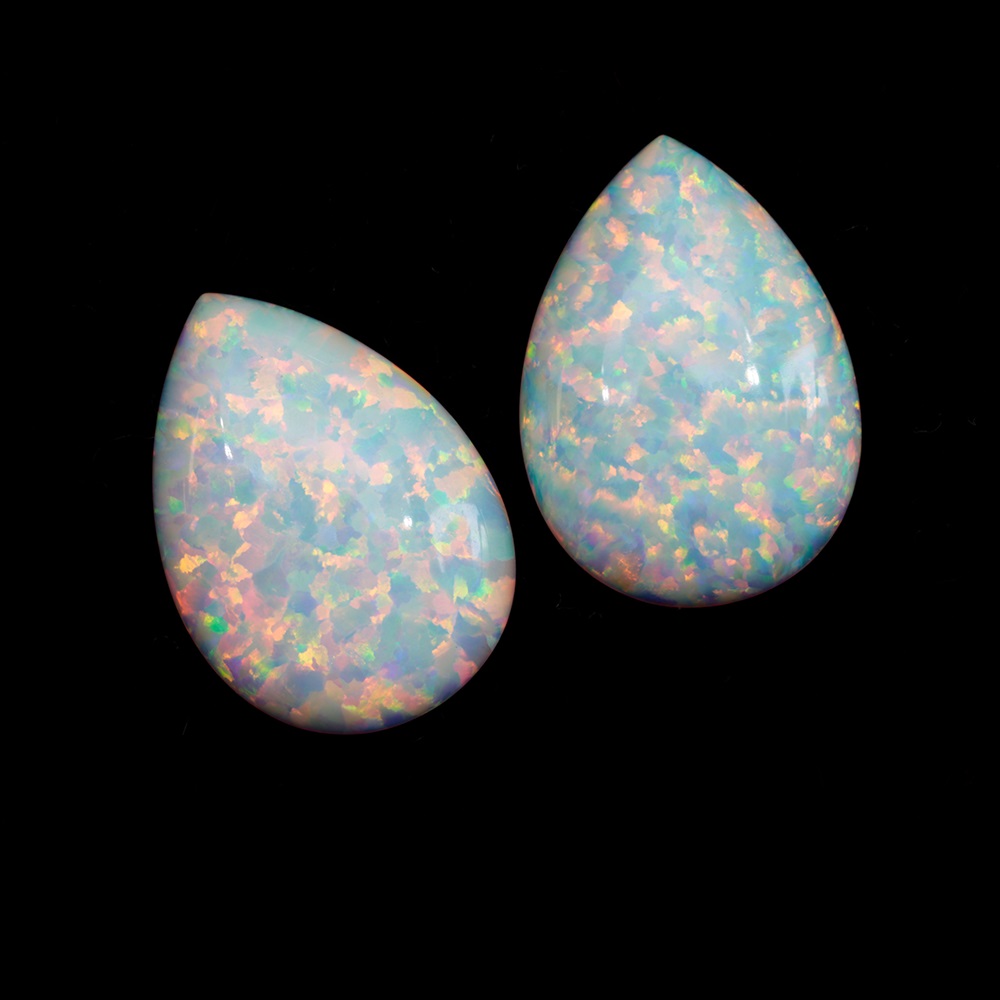
Synthetic opal (impregnated)
• Composition: 82 to 85% silica + 15 to 18% resin
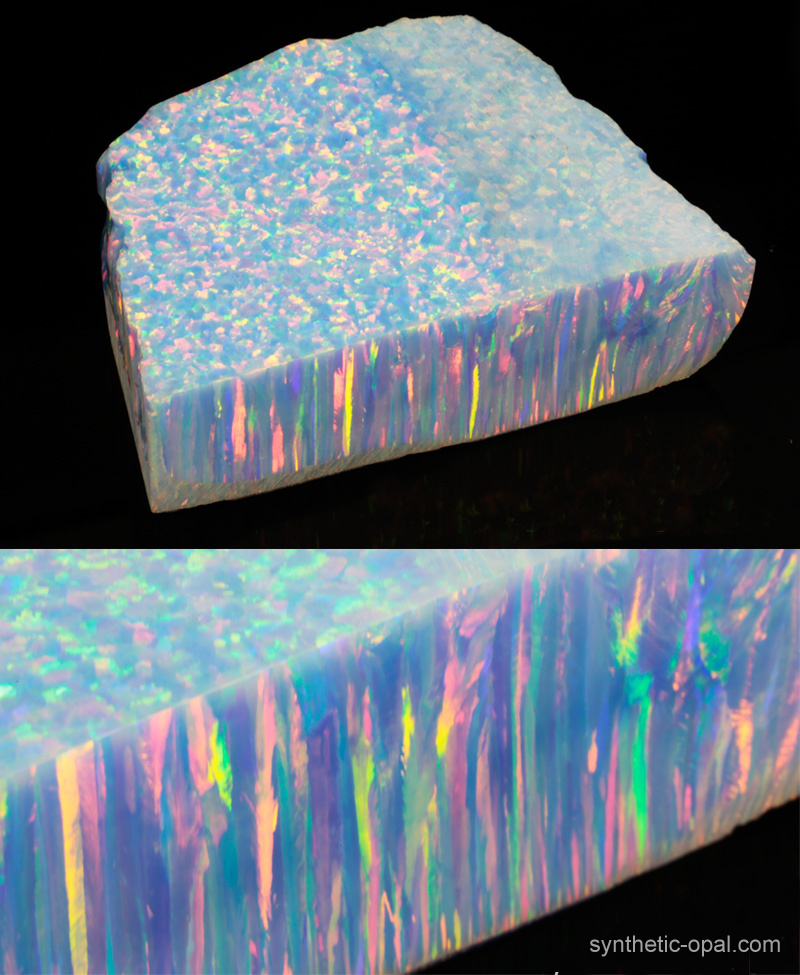
Data may vary depending on the manufacturer of the synthetic opal. It is mostly the same type of synthetic opal, under a different name or only differs in resin content.
As a complex explanation of what synthetic opal is, synthetic opal impregnated, laboratory treated, imitation, imitation and others can be seen in the manufacturers of synthetic opal themselves. Text from the synthetic opal manufacturer's questionnaire.
Question: What is the difference between synthetic opal and synthetic impregnated opal?
Manufacturer's Answer: The difference is that in impregnated opals, the cavities / space between the monodisperse silica particles are filled with polymer and not silica. Properties such as specific gravity, refractive index, hardness and temperature resistance therefore differ from synthetic opals. In the strict sense, "synthetic impregnated opals" are also imitations of opal. However, to distinguish both types of opals with silica particles embedded in the polymer from other materials with diffractive paints (other imitations with color change), we describe these opals clearly and distinctly as "impregnated synthetic opal" together with a descriptive term for patterns (non-directional / directional).
In such a long and complex text it is actually written that there is only one synthetic opal, everything else is just an imitation of opal. If you take a deeper interest in it, you will be completely lost in it.
According to the GIA (Gemological Institute Of America), synthetic opal must meet the following conditions:
• It must contain predominantly silica
• The structure of the opal must be formed by submicroscopic beads
• It must have gemological properties with a refractive index (RI) between 1.37 and 1.47
If, it meets these requirements, it can be described as synthetic opal, everything else is just an imitation of opal. These are still different criteria than for a synthetic gemstone
No type of synthetic opal has the same composition as natural. Therefore, even in chemical composition, we can not speak of a full-fledged substitute for natural opal.
Prices for artificial or synthetic opals range from US $ 0.01 - $ 20.00 / Piece. It depends on the quality and quantity. The minimum order quantity is often from 50 pieces. The more you order, the better the price.
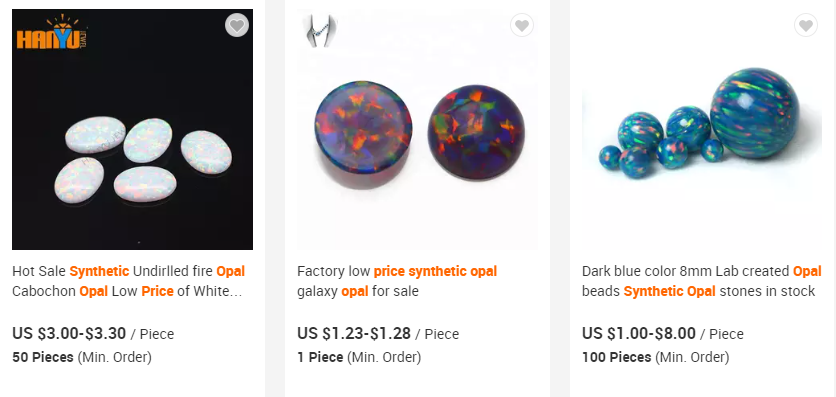
How is synthetic opal made?
The basic process of opal synthesis consists of three phases. By creating small quartz balls, which are then arranged in a grid, mimicking the structure of natural precious opal. Finally, the pores of the structure are filled with silicone gel until they harden completely. The whole process can take more than a year. The resulting material is a hydrated silica product that exhibits iridescence (a phenomenon of certain surfaces that can gradually change color as the angle of view changes or the angle of illumination, such as soap bubbles) and is recognizable from natural opal by the regularity of color spots. This opal is made by a process invented by Pierre Gilson in France in 1974, the product is called Gilson opal.
Most of the production is in China and Japan. The big manufacturers are Kyocera and Inamuri
The structure of synthetic opal

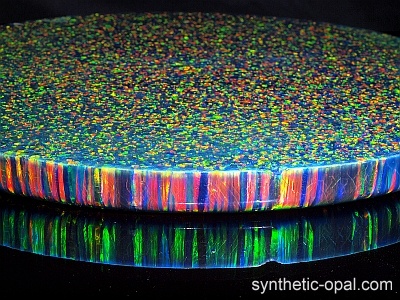
Structure of natural precious opal

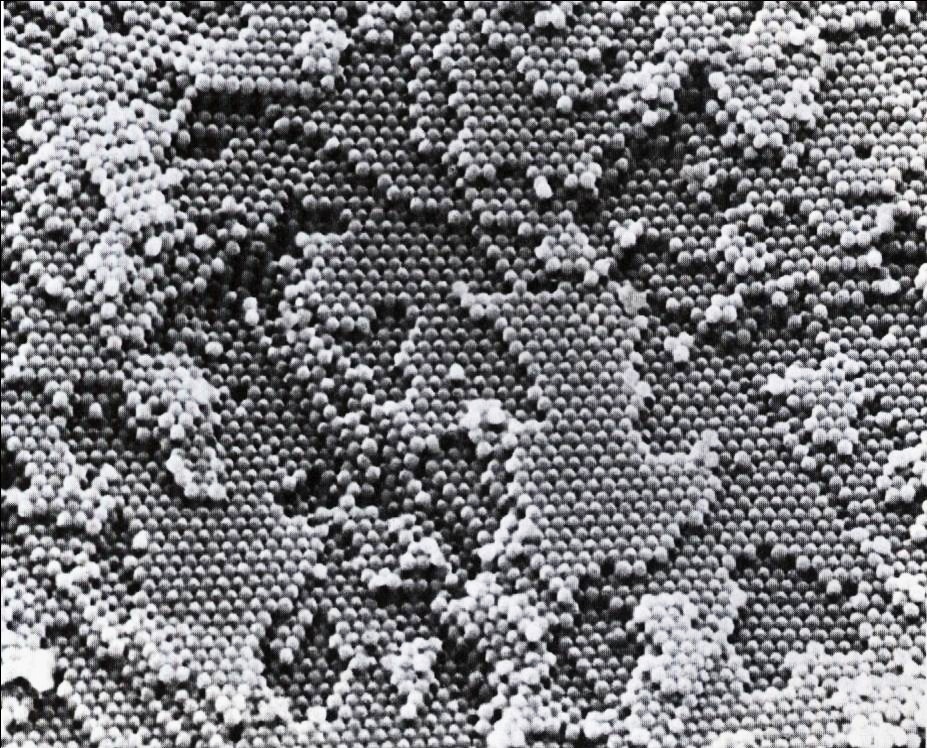
How do I know synthetic opal?
If you buy the opal itself or in jewelry, the seller is obliged by law to inform the customer that it is a modified opal. The information should be clearly and unambiguously given for a specific product.
With the naked eye:
- The colors are (mostly in the case of cheap imitation) unnaturally strong.
- For synthetic opal, no rock debris or sandy places are visible.
- If the opal on the other side has a sandy place or the rest of the rock, it is most likely a natural opal.
- If it is a pair or more pieces, usually all opals are exactly the same. The same color, arrangement of colors, it is a synthetic opal.
- If the opal is cut into a non-traditional shape, it is most likely a natural opal. The color of natural opal is the rarest and most valuable, so losing just a bit of color just because of the regular shape can be a financial loss.
Under the microscope:
- Columnar, lizard or regular structures of opal
- Unnatural weight, synthetic opal impregnated with resin often has a lower specific gravity than natural opal
- When sanding, you can smell plastic, the material decreases quickly, polishing is different than with natural opals
comparison of properties of synthetic and natural opal
Properties of synthetic opal
+ Low price
+ Distinctive color change
+ Varied selection of colors
+ Immediate availability in large quantities
+ Possibility of the same color combinations
- It does not replace natural opals, it only imitates them
- Impregnated
- Hardly recognizable imitation from high-quality synthetic opal
- It has no added value. The development of prices depends on production costs.
- Most synthetic opals contain dyes that disappear over time or may turn yellow
Properties of natural opal
+ Proven stability (especially Australian and Ethiopian opals)
+ A unique color exchange created by nature itself, thanks to which every precious opal is a complete original
+ An advantageous commodity, one of the few where immediate profit is possible.
+ And last but not least, the view of natural precious opal brings joy, smile, pleasure and this view never gets tired and is not measurable.
- High quality for opals or high intensity colors
- It is more difficult to compose a set of opals of the same color
Natural opal grinding
You can literally play with every natural precious opal you sharpen for a few days. You examine it, trying to imagine what colors stand out and what are still hidden. It's such a beautiful game in which there is a huge joy or a huge disappointment at the end. You grind everything much more slowly than other minerals, you care about each piece where the paint is located. You know opal like no other and you think you can't surprise you with anything. You come out of the workshop into the light and your jaw falls down again. Where did the colors and glow come from! Precious opal will never cease to amaze you.
Synthetic opal grinding
Synthetic opal is mainly produced in blocks, where the color distribution is clearly visible. Just cut a piece from the block and you can cut exactly the same opals with the same color. Grinding synthetic opal has no significance for gemstone grinders. Grinding synthetic opal, which smells of plastic, is not pleasant even for mineral enthusiasts.
Conclusion
I would rather write about something interesting from the world of natural opal than about a topic that does not specifically concern me, but I owe this article to the whole world of natural opals. I am grateful to have discovered this world and to belong to it. This world is not just about colors and money, but mainly about people who have been completely captivated by precious opal. Once an expensive opal gets you, it will never let you go. Business meetings tend to be much more personal and some of my customers eventually became friends. This world is above all joy and pleasure. Even in this, the two worlds are completely different.
Synthetic opal was created from a very complicated process and as an imitation of opal it is at a very high level. The development is constantly shifting and I believe that one day we will be able to produce even more successful imitations of opal. Progress cannot be stopped. Just as not all things created by nature itself can be copied. If in the future it is possible to produce an imitation with exactly the same composition as natural, then there is still a factor of the structure of the color change, which is unique in every natural opal. Natural precious opal cannot be fully replaced, it can only be imitated.







